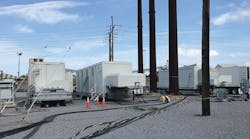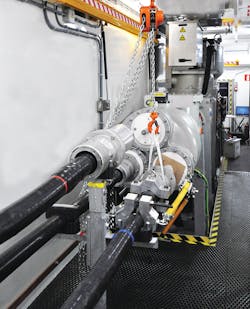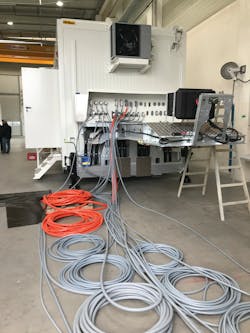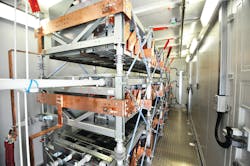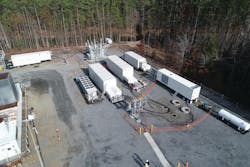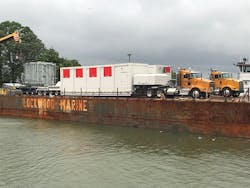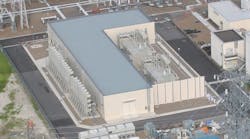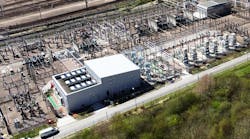For decades, changes to the transmission system traditionally have been slow and incremental, as load growth and development were methodical and predictable. System planning engineers had solid 5-year and 10-year plans with little to no variations. Today, environmental regulatory changes and new generation incentives have become a catalyst for profound modifications to transmission systems. Shifts in generation resources coupled with environmental pressures and economic incentives to install renewables have changed dramatically the way power utilities plan and develop transmission systems.
Older generation stations are being retired, and developers are developing renewable generation sites more rapidly than ever before. As a result, transmission owners require a flexible solution to design system upgrades with rapid changes to supply. For many utilities, new generation resources often are referred to as inverter bases recourses (IBRs) because they are electronic. These new IBRs are interconnecting in rural areas — in many cases, remote from existing build-outs of grid infrastructure. En masse, these developments and retirements compound in a way that creates several planning, operations and project execution challenges. Voltage management with traditional mechanically switched devices may no longer be feasible in certain scenarios.
Adapting to this new normal involved a significant investment in the transmission system to support these new resources. New transmission lines, reconductored transmission lines, and the installation of shunt capacitors or reactors are examples of what may be required for the grid to function properly. Dominion Energy Inc. set out to create a solution that can mitigate system instability challenges in the short term while simultaneously developing a long-term design and construction strategy.
A Short-Term Solution
A technical difficulty for many transmission system operation centers involves maintaining excellent levels of reliability while navigating the complex outages and configurations required to execute large capital projects. Outages required during construction of transmission assets can cause congestion, overloads and contingencies that stress elements of the transmission system. During these upgrades, the transmission system often is exposed to complex configuration evolutions and abnormal conditions. For example, when reconductoring transmission lines, the remaining transmission lines can become overloaded and cause voltage violations for specific loading levels and contingencies. Because of seasonal loading levels, utilities must schedule construction carefully to prevent overloads, voltage violations and restoration headaches.
Larger-scale projects often are paused so certain elements of the project can be restored to meet winter and summer peak loading levels. Such pauses can significantly lengthen the duration of a critical project necessary for grid development. During these intervening times of abnormality, the system often is more vulnerable to otherwise normal threats, such as weather disturbances. The longer the system is abnormal, the higher the reliability risk from unplanned outages.
When Dominion Energy launched a project to rebuild and construct several transmission lines to strengthen the grid in preparation for the retirements of two coal generating units at its Yorktown power station, the utility recognized potential reliability gaps that needed to be addressed during the multiyear project. Installation of flexible ac transmission system (FACTS) devices could provide the necessary transient and steady-state voltage support. At the same time, these devices would only be needed during the construction or transition stages before the permanent transmission work was complete. A traditional permanent FACTS deployment, such as a static voltage-ampere-reactive compensator (SVC) or static synchronous compensator (STATCOM), would not be cost effective or reasonable since the devices would no longer be needed after long-term solution was in place.
Mobile STATCOM
Dominion Energy knew from experience its STATCOM devices were highly effective in managing system instability, so the utility’s engineers launched a project to develop the world’s first mobile STATCOM device. A study of Dominion Energy construction projects revealed fault-induced delayed voltage recovery (FIDVR) phenomena would become more profound at higher load levels for multiple projects. Without additional FACTS support, the only alternative would be to perform construction during light load periods, an impact that could be measured in years. With the mobile STATCOM, line construction projects could be continuous throughout seasonal load fluctuations, resulting in significant savings and enhanced reliability.
The development of a modular multilevel converter (MMC) for voltage source converter (VSC) application made a mobile STATCOM possible. The MMC is smaller in size than traditional line-commutated converters. When designing mobile solutions, size and weight are the driving factors. Dominion Energy’s challenge was to adapt the proven design of permanently installed STATCOMs within a fixed substation environment to a mobile concept. The requirement involved multiple engineering disciplines, including mechanical, civil and electrical.
A tremendous challenge was to convince a manufacturer the concept was not only possible but resilient. The components were adapted from the manufacturer’s traditional stationary STATCOM to fit in trailers that could be relocated and redeployed multiple times. Modular plug connections and make-up boxes were used to streamline repeated installation and removal.
The key to facilitating mobility was to separate the MMC design into segments that could be connected back together as the engineering marvel was relocated to new locations. The orientation of the trailers was designed to be highly flexible because the deployment site locations would vary greatly.
The mobile STATCOM consists of three trailers:
- Arm reactor trailer
- Inverter hall trailer
- Auxiliary trailer.
The ability to configure the solution to fit the available space by using insulated cables and air-insulated interfaces creates flexibility and ease of application. The reduction of electrical exposure and compact trailers ensures maintenance activities can be performed wherever the STATCOM is deployed. Less electrical exposure ensures greater reliability and reduces the electrical clearance and minimum-approach distance challenges at each installation site.
The high-voltage and medium-voltage cables are specially designed to be reusable and can be coiled back on the wire spool for transportation. The interconnections for control, protection and sensing are premade with Hartling plugs, each uniquely shaped so they can only be plugged into the correct socket. Current circuits use regular terminal blocks in make-up boxes for safety purposes. The speed and accuracy of installation are enhanced, and human performance errors that can occur during wiring are eliminated with unique-shaped connections while maintaining a strong safety focus.
The mobile STATCOM control scheme also has a unique safety feature. For example, Kirk keys prevent inadvertent access to any energized area or cabinet. The main key is controlled by the human-machine interface and counts down the time lethal charge is bled off the system; only then would it allow access to the first Kirk key to close a ground switch. Once the ground switch is closed, all other access keys to cabinets and protected areas are available. Grounding points have been installed and oriented inside the trailers so traditional grounding practices used by substation field personnel can be used without difficulty or hazard.
The grid interface or step-up transformer has a dual-voltage high-voltage winding so the mobile STATCOM can be deployed on Dominion Energy’s 230-kV and 115-kV systems. The controller even has a feature that tests the transformer connection to ensure the control is set for the correct voltage application. How cool is that?
To ensure the transformer is tapped incorrectly, the mobile STATCOM performs an impedance test and compares the results to known preprogrammed values. Any mode incongruities result in tripping the source breaker and providing an error message to the operator. The control voltage selection feature protects the mobile STATCOM from being placed into service with a mismatched configuration and any associated equipment from being damaged because of a human performance error.
To adhere to the U.S. Department of Transportation’s lane restrictions, the heat exchanger was designed to be on a rotating pivot, stored for travel and deployed for operation. With the removal of less than a dozen bolts, the heat exchanger can be rotated around so it is on the inside of the trailer for travel. This maximizes the use of space and simplifies transportation.
Relocating Mobile STATCOM
As anticipated, once the construction of the transmission lines was complete, the mobile STATCOM was needed at a new location. Multiple factors must be considered when relocating it. The site selection and evaluation process for the mobile STATCOM provides a challenge beyond the installation of traditional permanent FACTS devices. The process is even different from that of more conventional mobile substation equipment. While the versatility of the mobile STATCOM allows for installation within a substation or tapped from a transmission line, fully understanding the necessary civil engineering, including but not limited to grounding, soil testing, transportation logistics and vehicle access, is a critical preparation.
Mobile transformers and standard substation equipment have been installed for years using temporary grounding installations that provide adequate safety and protective functions for personnel and installed devices. The core structure of the mobile STATCOM, consisting of three trailers, contains sensitive electronics, arresters for overvoltage protection and reactive power elements.
First and foremost, when selecting a location, full grounding evaluations need to be performed. In some cases where the optimal location is for the equipment to be connected in a transmission line right-of-way, this means performing soil resistivity testing, installation of a full ground grid as well as a physical perimeter to ensure public safety from step and touch potential. In each case, grounding equipment should be installed and verified prior to the installation of mobile equipment.
A second consideration for site selection is transportation access. The mobile STATCOM trailers have been designed and constructed to allow for transportation on large roads with limited permitting requirements. However, inevitably, the site in most dire need of reactive power support likely will be one of the most difficult to reach with significant access restrictions. Transportation professionals who routinely move large loads are extremely helpful in route selection as well as to provide alternative methods of relocation to meet even the most aggressive schedule. Special permitting for bridges, route selection because of height restrictions and an understanding of the transportation time are important factors in this case.
Another important piece of the transportation puzzle is to identify the proper order, position, and means of access and egress for both the mobile STATCOM equipment and the support vehicles being used for the installation. While it may seem simple to arrange a layout on paper, the practice can be quite detailed.
For larger equipment, such as the mobile STATCOM trailers, how will the trucks safely enter and exit the selected location? Is there enough room for a crane to set up the transformer? Which components get set first? What elements need to be placed last? These questions are critical to ensuring a successful moving day. While it may seem like a lot to consider, there also are considerations for the maintenance personnel. Placing travel paths and access locations for test equipment to be brought in will save significant time and physical exertion in the future.
A final consideration for mobile STATCOM site selection is the availability of a station service power supply. Even though the mobile STATCOM is powered by an internal station service transformer while the system is in operation, this device requires a secondary reserve-power supply to keep the systems energized while the mobile STATCOM is in standby mode or during planned maintenance outages, installation periods or emergencies. Like a miniature power station, reserve station service serves as a supply provided from the transmission system. It is best to have this power supply segregated from the point of common couple of the mobile STATCOM.
In a substation installation, having a feed from a distribution voltage source is ideal, or from a nearby distribution circuit if using a transmission line right-of-way. For any configuration, the reliability of this source should be verified. When connecting the station service to the mobile STATCOM, the reserve feed passes through an auto-transfer switch prior to energizing the internal systems. Proper analysis for phasing and rotation is critical when designing this installation to ensure the internal source and reserve source are aligned.
Because the internal source is only energized when the mobile STATCOM is placed into operation, it is important the initial energization is performed with this auto-transfer switch in the manual mode. This ensures the switch will not transfer and allows phasing to be tested with a standard meter to verify accuracy.
Detailed Planning
With the location determined and the civil, electrical and logistic evaluations complete, final preparations can commence. With the large equipment coming into place like an enormous game of Tetris, the station service feed being wired up and the inter-trailer connections being made up, there will inevitably be multiple tasks that require the same areas to continue work. Getting ahead of the installation by prioritizing the critical or long-duration tasks and organizing what crews are working in each trailer cannot be understated. It is very easy to have more than three dozen individuals working at the same time on such a mobilization. Expert choreography of the activities will minimize idle hands and maximize efficiency.
Mobile substation equipment can be sent to the furthest and most remote corners of the transmission network. With the power and potential of the mobile STATCOM, it is certainly no different. Mobile STATCOMs can go anywhere the grid can go.
For Dominion Energy, this flexibility has meant exposure to two separate hurricanes at two separate locations. In the first installation, additional weights were tethered to smaller support equipment and equipment was elevated to prepare for up to 3 ft (0.9 m) of standing water. At the second installation, where high winds were more of a concern than standing water, additional forestry and wind loading studies were performed in the area. The utility found the mobile STATCOM can withstand these events and continue to serve the transmission system when it is needed most.
The Next Evolution
The development of mobile FACTS devices is the next logical step to support the evolution and development of a modern electrical grid. What makes the development of a mobile STATCOM special is the diversity of applications and benefits to any utility.
The mobile STATCOM gives utilities the flexibility to develop short-term plans while successfully constructing a long-term solution. The ability to reduce outage contingencies and improve economic opportunity were the driving force. Necessity is truly the mother of invention.
